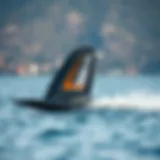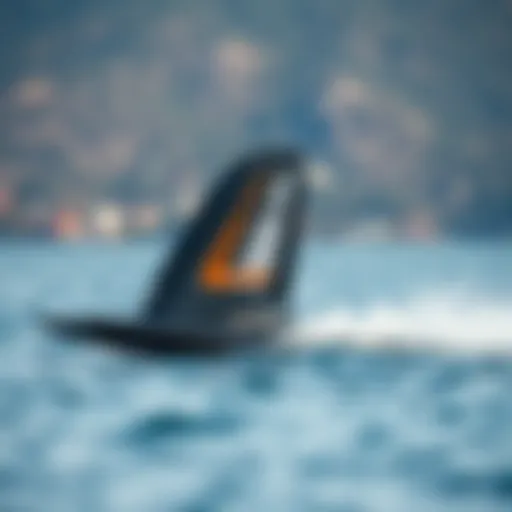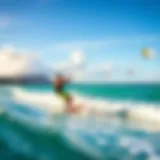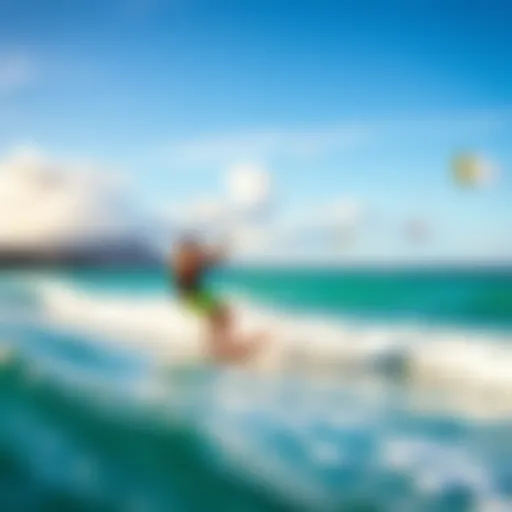Choosing the Best Wing for Kiteboarding Foiling
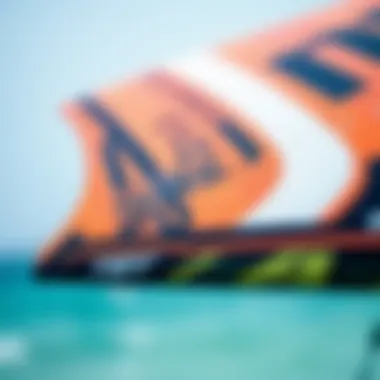

Intro
When it comes to kiteboarding, the choice of wing for foiling can make a world of difference in performance and enjoyment on the water. Selecting the right wing isn’t just about picking something that looks good or matches your kite’s color scheme; it's about understanding how various factors, such as design features and materials, can influence your experience. Whether you’re a newcomer to foiling or you have spent countless hours riding the waves, this guide aims to cut through the noise and equip you with the insights you need to make the best decision.
Understanding the nuances of wing choice can lead to a more enjoyable ride, whether you’re carving through waves or making your first tentative steps into foiling. As you dive deeper into the intricacies of wing selection, you will find that factors like wing size, shape, and flexibility can provide advantages tailored to your unique style and conditions. In this guide, we will break down each aspect to ensure you have not only the knowledge but also the confidence to enhance your kiteboarding adventures.
Gear Insights
A well-chosen wing is not only essential for peak performance, but it also contributes to your overall safety and enjoyment. Let’s explore the current landscape of foiling gear and what you should consider when selecting your perfect wing.
Latest Gear Reviews
In recent years, the market has witnessed an influx of innovative designs and materials in foiling wings. Riders now have a broader range of products to choose from than ever before. Notably, brands like Duotone and Slingshot have introduced wings that feature improved stability and gliding capabilities, which appeal to both beginners and experts.
- Duotone Echo: This wing is celebrated for its lightweight construction, making it a favorite among freeriders. Its higher aspect ratio allows for excellent speed and performance without sacrificing control.
- Slingshot Slingwing: Known for its versatility, the Slingwing excels in various wind conditions and is tailored for those seeking to push their limits. Its durable materials ensure longevity, even in harsh conditions.
- Naish S25: Aiming at a premium audience, the Naish S25 offers remarkable handling and responsiveness, appealing to those pursuing freestyle foiling.
Essential Gear for Beginners
For those just starting their foiling journey, selecting the right gear can feel overwhelming. A solid setup tailored for beginners will help build confidence and foster an enjoyable learning experience.
- Lighter Wings: Beginners should look for wings that are 4m to 6m in size, which provide enough lift without overwhelming power.
- Medium Aspect Ratio: A medium aspect ratio will offer a balance of speed and stability, making it easier for newcomers to gain control.
- Safety Leashes: Ensure your kit includes reliable safety leashes to prevent losing your gear in the water.
By investing in the proper gear, especially tailored for your experience level, you’ll be setting yourself up for success. Knowledge about current trends and the must-have tools is fundamental to embarking on your foiling adventure with a firm footing.
"The right gear helps you ride the waves of progress with ease and confidence."
Remember, as with any sport, personal preference plays a massive role. A wing that suits one person might not deliver the same experience for another. Experimentation and familiarity with your gear are vital for honing in on what feels just right for you.
Understanding Foiling
Foiling has transformed the landscape of kiteboarding, bringing a unique blend of excitement and challenge to riders of all abilities. This section lays the groundwork for understanding why selecting the right wing for foiling is crucial. By delving into its fundamentals and benefits, we can equip enthusiasts with the knowledge they need for an outstanding ride.
When we talk about foiling, we mean riding above water on a board connected to a hydrofoil. This setup allows for a smoother and faster experience. The critical role of the wing cannot be overstated, as it directly influences lift, stability, and overall performance.
The Basics of Foiling
Foiling is about more than just gliding on water. It's an art that requires harmony between rider and gear. At its core, foiling involves using a hydrofoil—a structure extending underwater with wings to lift the board as speed is gained. Here are some basic elements:
- Hydrofoil Structure: A foil consists of a mast, wings, and a fuselage, where each component plays a distinct role in how well the rider lifts off. A longer mast allows for greater clearance from waves, while wings vary in shape and size, influencing lift.
- Speed and Lift: The faster you go, the more lift you generate. However, the relationship isn't always straightforward; the design of the wing can make a significant difference. Precise control is necessary to balance speed with stability.
- Board Connection: Riders use foot straps or a pad to connect with the board. This setup aids in control but requires practice to master. Finding that sweet spot where comfort meets performance is key.
The essence of foiling lies in its ability to deliver an exhilarating yet serene experience, floating above the water's surface. An understanding of these basic elements is crucial for both beginners and seasoned riders looking to elevate their game.
Benefits of Foiling
Foiling brings an array of benefits that go beyond the thrill of soaring above water. These advantages are what attract so many to this captivating sport:
- Enhanced Speed: The ability to ride a foil reduces drag significantly compared to traditional boards. This means less resistance and more velocity, allowing for a thrilling experience.
- Versatility in Conditions: Foiling expands the range of riding conditions. It opens the door to exploring gusty winds and smaller waves, making sessions available in tricky weather.
- Easier on Joints: With a foiled setup, the energy impact on your body is minimized as the board is above the water. This allows riders to enjoy longer sessions with less fatigue.
- Unique Riding Experience: The feeling of being airborne while riding remains unmatched. It’s akin to flying, which adds an entirely new dimension to kiteboarding.
Wing Foil Anatomy
Understanding the anatomy of a wing foil is like knowing the inner workings, or the bones, of a living creature. Each part plays a critical role in ensuring the performance and efficiency of the wing while you’re out on the water. From beginners just dipping their toes into the world of foiling to seasoned pros fine-tuning their setups, grasping these elemental features can give one an edge in their foiling experience.
Key Components of a Wing
Leading Edge
The leading edge of a wing is the frontmost part that faces the wind. It contributes significantly to the overall aerodynamics, greatly impacting lift and speed. The best part is that a well-designed leading edge can aid in reducing drag, thus enhancing performance. You see, a rounded leading edge is popular because it helps maintain airflow, which is crucial for keeping the ride smooth and stable.
A notable characteristic of the leading edge is its shape; typically, it’s more rounded at the top and flatter underneath. This design allows the wing to slice through the air and water with less resistance. However, not all leading edges are the same; some might have reinforced materials to withstand wear and tear from frequent use. The trade-off here is additional weight, but it's often worth it for the added durability when tackling rough conditions.
Struts
Struts act as the backbone of a wing, providing necessary support and structure. They hold the wing's shape in place, preventing deformation under pressure during maneuvers. A well-placed strut can offer improved stability at various wind speeds, enhancing rider confidence, particularly for newbies who might feel a bit shaky at first.
The strut’s characteristic feature is its lightweight construction, which plays a role in overall wing performance. Materials used in struts can vary from aluminum to carbon fiber, each have unique strengths and weaknesses. The advantage of a strong, lightweight strut is clear: better responsiveness and less drag. On the flip side, materials can also affect the cost of a wing, so it's a balancing act depending on personal budget and intended use.
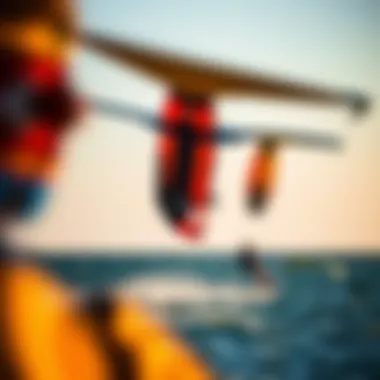
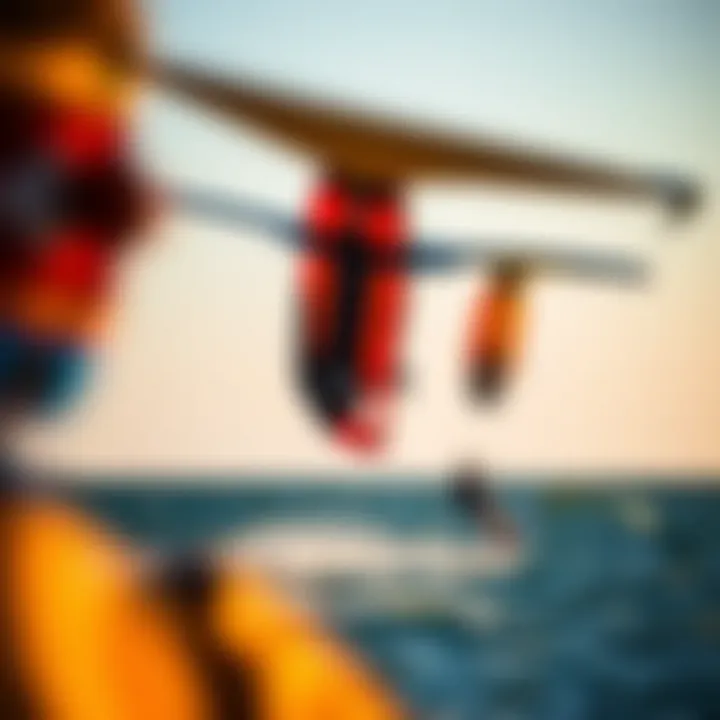
Trailing Edge
The trailing edge is where the air and water finally exit after interacting with the wing. This part influences how wind flows off the wing, providing a finishing touch to the lift and drag dynamics. A well-designed trailing edge can minimize turbulence, which in turn enhances efficiency.
A key characteristic here is the cut – some trailing edges are serrated or scalloped to enhance airflow control. This design can often mean smoother rides in choppy water. However, if not crafted carefully, a trailing edge might wear down more quickly, especially if you're one to push your limits on the surf or foil.
Canopy Shape
The canopy shape determines how air interacts with the wing’s surface, influencing both lift and overall flight characteristics. A curvy, high-arching canopy can create more lift but might require precise handling when it comes to control. On the other hand, a flatter shape often provides better stability and is favored by many beginners, who may seek a less responsive setup until they grow accustomed to foiling.
One unique feature of canopy shapes is the variation in aspect ratios. Wings with a high aspect ratio are great for speed, whereas low aspect ratio wings tend to provide more maneuverability. However, high aspect wings can be tricky in rough conditions as they require better techniques to manage effectively.
Materials Used in Construction
Durability Considerations
When you're selecting a wing, understanding durability is crucial, as it impacts both safety and cost-efficiency in the long run. A wing crafted from robust materials is more likely to withstand the ebb and flow of harsh winds and ocean conditions. Those new to foiling may not see the immediate benefits of durability, but over time, it pays off big time.
A common material for durability is ripstop nylon or polyester, known to resist tears and maintains strength even when wet. Yet, one needs to care for these wings to ensure their lifespan is maximized. The immediate downside is usually the price tag; higher durability often comes with a steeper investment, but it could save you in replacements later.
Weight vs. Strength
The balance between weight and strength is a real tightrope walk when choosing wing materials. A heavier wing might seem more durable on paper, but it can drag even the most enthusiastic kiteboarder down. A feather-light wing made from advanced materials can enable better lift and speed, allowing riders to harness winds with ease.
However, lightweight options may compromise on strength. Take carbon fiber, for instance; it’s lighter than its fiberglass counterpart but may be more prone to damage under extreme stress. Riders will have to weigh their personal priorities—speed and performance or strength and resilience—when making a choice.
Conclusion: Understanding wing foil anatomy, including its essential components and the materials used in construction, ensures informed decisions in wing selection, optimizing performance and enhancing the overall foiling experience. This foundational knowledge translates to greater confidence and skill as one navigates the breathtaking world of kiteboarding.
Factors Influencing Wing Selection
Selecting the right wing for foiling is much like choosing a sturdy pair of shoes for a hike; it requires an understanding of your personal needs and the specific conditions you’ll face. This section digs into the various factors that can sway your decision while ensuring you get the most out of your foiling experience. A wise choice is shaped by several elements like your skill level, wind conditions, and personal riding style. Each of these factors affects not only how you perform but also the enjoyment you derive from your time on the water.
Skill Level Considerations
Beginner Needs
For novices trying their hand at foiling, the right wing can make or break their initial experiences. New riders typically benefit from wings that offer greater stability and ease of use. Beginner wings are designed to provide ample lift at lower speeds, making it simpler to get up and ride without excessive effort. This characteristic is crucial as it allows for easier learning curves and boosts rider confidence.
However, there’s a trade-off; these wings may not be as responsive or agile, which could be limiting once a rider starts developing skills. The unique feature here is the wide aspect ratio, which enhances balance yet might compromise speed on stronger winds. So, while beginner wings are often deemed favorable for learning, they have their limitations that riders need to keep in mind.
Intermediate Adjustments
As foiling skills progress, riders often lean towards intermediate wings that offer a balance between sensitivity and stability. Riders at this level may favor wings that feature adjustable settings to adapt to their evolving techniques. Intermediate wings are designed with responsive shapes, providing a thrilling element without losing control. This characteristic allows for improved maneuvers and tricks, such as jumps and turns.
The flexibility of these wings helps bridge the gap as riders push their limits. Yet, a potential downside is that they may still possess some bulkiness compared to advanced options, which could slow down performance in competitive scenarios. Riders transitioning from beginner to intermediate must consider what they gain in agility against possible speed losses.
Advanced Preferences
For seasoned foilers, the wing selection becomes a reflection of personal style and performance aspirations. Advanced wings may come with specialized designs that prioritize speed and agility. Those at this stage often seek wings that cater to their specific riding style, whether it's aggressive racing or artistic maneuvers.
The sleek designs and lighter materials offer faster acceleration with precise handling, an alluring characteristic for those wanting to conquer challenging waves or compete. However, it's important to note that these wings can be more demanding in terms of handling, requiring adept control and experience. Riders embracing this choice must weigh the thrill of high performance against the added complexity in maneuvering their equipment.
Wind Conditions and Their Impact
Light Wind Wings
When the breeze is barely rustling the trees, light wind wing designs come into play. These wings are particularly crafted to maximize lift even in gentle winds, which makes them an ideal choice for calm days. A key feature of light wind wings is their larger surface area that catches the faintest winds efficiently.
The main benefit here is the enjoyment of foiling when conditions otherwise might not permit it, allowing riders to hone their skills and spend time on the water. Yet, it’s crucial to know that these wings can feel sluggish when faced with stronger winds, potentially causing challenges with control during sudden gusts. While they offer accessibility, they could become unwieldy in more dynamic conditions.
Strong Wind Implementations
Conversely, wings engineered for strong winds are built to tackle gusty conditions with robust designs that ensure stability and control. Strong wind wings feature a more compact size, which curtails the potential of excessive lift but enhances response and agility. This design element is essential for high-speed rides and tackling tougher terrains that often accompany rougher weather.
Unlike their light wind counterparts, these wings allow riders to slice through the surf with precision. However, they can be demanding for inexperienced riders, as they require more skill to operate effectively. Understanding when to utilize these wings ensures that speed does not outpace control, enhancing rider safety and enjoyment.
Personal Riding Style
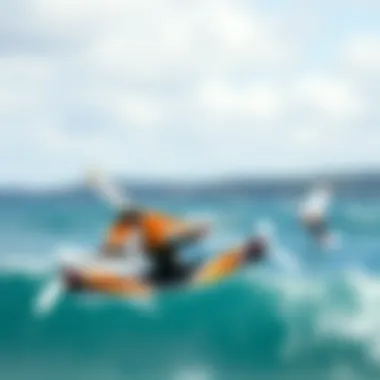
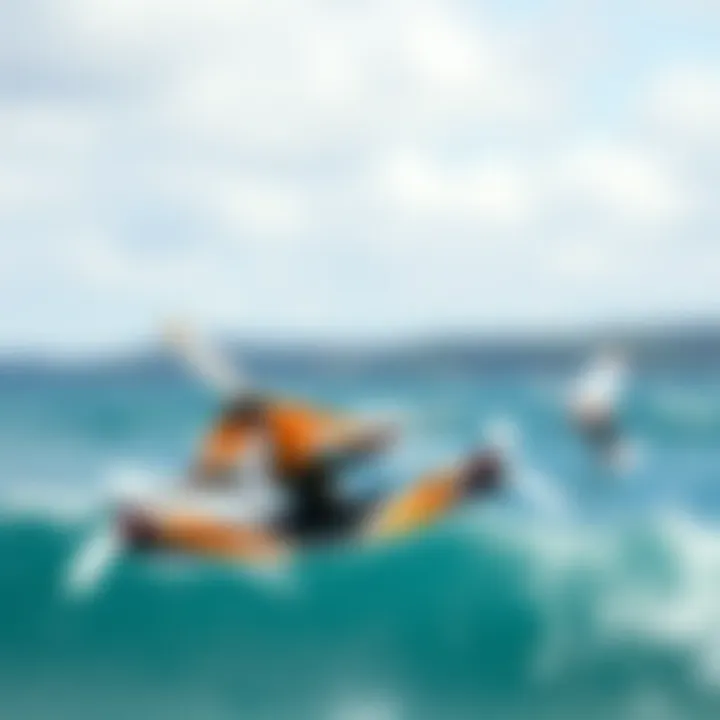
Freeride versus Freestyle
The distinction between freeride and freestyle wings is significant, as it speaks volumes about a rider’s preferences and performance goals. Freeride wings are optimized for smooth cruising and comfort, making them a go-to for those enjoying the scenery and gradual maneuvers. They generally possess more stability and are forgiving to handle.
On the flip side, freestyle wings prioritize agility and responsiveness, ideal for trick enthusiasts looking to impress the crowd with daring aerial feats. Each type presents its unique benefits; freeride is appreciated for leisurely sessions, while freestyle feeds the adrenaline junkie’s thirst for the spectacular. The choice between them can greatly influence a rider's experience on the water, laying down the groundwork for a fulfilling foiling journey.
Racing Considerations
In competitive settings, the selection of racing wings is crucial for peak performance. Racing wings are specifically designed to maximize speed and efficiency. Characteristics such as a narrower wing span and reduced drag play a pivotal role in propelling riders to higher speeds. These wings often incorporate advanced materials that provide both strength and lightweight properties.
While this design allows for blistering speeds, it does present challenges. Achieving the desired performance may require a higher level of skill and technique. Moreover, the experience can be less forgiving during mishaps, highlighting the importance of understanding personal capabilities before opting for racing wings.
Ultimately, selecting the right wing for foiling hinges on many factors, from skill and style to environmental conditions. By knowing these elements, you can confidently navigate your choices and find the wing that’s right for you.
Wing Size and Performance
When it comes to the world of foiling, wing size looms large as a significant factor affecting your performance on the water. Understanding how different sizes influence lift, stability, navigation, and overall ride comfort is paramount to making the right choice for your needs. From small precision wings to large stable types, each has its own advantages that can either enhance your experience or leave you floundering. A suitable wing size caters to not just the wind conditions but can also complement your specific riding style.
Impact of Wing Size
Small, Medium, and Large Wings
Wings come in various sizes - small, medium, and large, and each serves a different purpose. Small wings, for instance, are characterized by their agility and speed. They cut through the water like a hot knife through butter, making them ideal for high-performance maneuvers and advanced tricks. The compact size also means less drag, allowing for swift transitions.
On the other hand, medium wings strike a fine balance between speed and stability. They provide enough lift in moderate winds without compromising control, making them a popular choice for those who are still fine-tuning their skills or for riders experiencing changing conditions. Finally, large wings are reminiscent of giant sails. They are phenomenal for lighter wind conditions, often found in races or leisurely cruising. Their larger surface area gives an rider enhanced lift and stability, creating a more forgiving experience, especially when you're still finding your feet.
Each size has its own unique features and potential drawbacks, but ultimately, the appropriate choice depends on what you're aiming for on your foiling adventure.
Performance Trade-offs
While selecting a wing size, understanding performance trade-offs is crucial. Choosing a small wing may grant you speed, but it can compromise stability, leaving less experienced riders feeling jittery in gusty conditions. Those smaller wings can be a thrill, yet the potential for erratic flight patterns could also mean more time practicing your recovery skills.
Conversely, large wings bring robust stability to the table but might lack the thrill of nimble turns that seasoned riders crave. They may feel cumbersome and could hold you back from those lightning-quick maneuvers that let you strut your stuff among fellow riders. Essentially, every size will compel its rider to adapt, balancing the trade-offs between lift, speed, and control.
Lift and Drag Dynamics
The relationship between lift and drag is a key player in how wings perform on the water. Understanding these dynamics not only enhances your riding technique but can significantly affect your enjoyment on the water. Lift is the upward force generated as the wing moves through the air; it's essential for foiling, while drag is the opposing force that slows the wing down.
Optimizing lift while minimizing drag leads to a smoother experience. Slender and well-designed wings can typically produce greater lift for less drag, which is perfect for those wanting to glide effortlessly over waves. This becomes particularly vital when conditions shift unexpectedly, demanding quick adjustments on your part.
When selecting your wing, pay close attention to how its size will affect the balance between lift and drag. The ultimate goal is not just to fly but to do so with grace and efficiency, ensuring that every moment on your board is pure exhilaration.
Remember: Choosing the right wing size and understanding lift and drag can make or break your foiling experience. Be sure to evaluate your skills and style when making decisions.
For further information on wing dynamics, resources like Wikipedia or Britannica can offer great insights.
Choosing the Right Shape
Selecting the right shape for a wing in foiling is both an art and a science. The shape is not merely about aesthetics; it directly influences how the wing performs on the water. Understanding this aspect can make or break your foiling experience. Different shapes cater to various riding styles and conditions, and knowing what works best for you is essential for achieving optimal lift, stability, and responsiveness.
The choice between high and low aspect ratios, as well as various design shapes like dihedral and symmetrical forms, creates a nuanced landscape for riders. The shape impacts not just performance metrics but also the rider's overall comfort and confidence on the water.
The Influence of Wing Shape on Lift
High Aspect Ratio Wings
High aspect ratio wings are popular for their sleek design and are often the go-to for riders seeking speed and efficiency. They stand out with their elongated wingspan compared to their chord, which is the distance from leading to trailing edge. This distinctive structure allows for better lift-to-drag ratios, making them favorable for light wind conditions. The primary benefit of high aspect ratio wings lies in their ability to slice through the air with less resistance.
However, the trade-off is that they can feel less stable in turbulent conditions. Riders may need advanced skills to utilize the full potential of these wings. What’s worth noting is their inherent capability to perform well in gliding, contributing to higher speeds once they're up on the foil.
Low Aspect Ratio Wings
On the other hand, low aspect ratio wings are characterized by a shorter span and a broader chord. These wings excel in providing greater stability and maneuverability, thus are often preferred by beginner and intermediate foilers. The unique feature here is that they distribute lift more evenly, which translates into easier handling and less nervousness when out on the water.
Low aspect ratio wings, however, may experience more drag, especially when compared to their high aspect cousins in higher-speed scenarios. They tend to be the underdog in chasing those racing records but shine in free-riding and perform well in choppy conditions. Ultimately, they foster a balanced approach for riders looking to hone their skills.
Planning for Stability
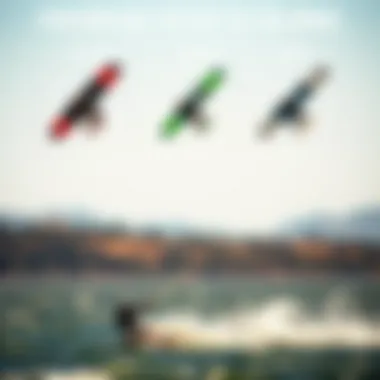
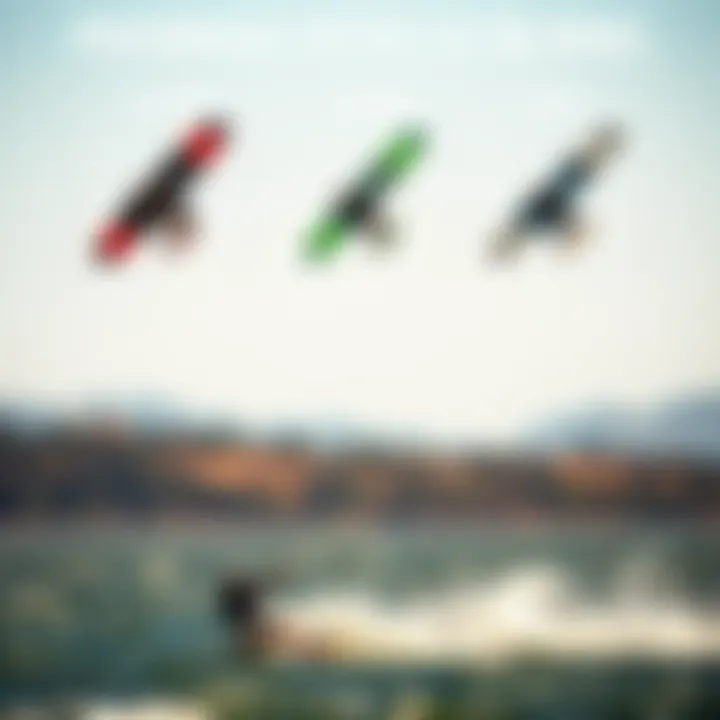
Dihedral Shape Considerations
Dihedral shape wings feature an upward angle, which plays a crucial role in enhancing stability during flight. When the angle is set right, these wings are better equipped to deal with crosswinds, making them advantageous for those unpredictable water moments. This upward design effectively supports a smooth ride, as it assists in maintaining level flight despite minor shifts in balance. It’s like having an extra safety net that keeps you on track.
However, not all riders appreciate the dihedral design given its specific handling characteristics, which might not suit everyone, especially aggressive surfers looking for high-speed maneuvers. Still, for those seeking comfort and stability, dihedral is often regarded as a dependable choice.
Symmetrical vs. Asymmetrical Designs
The debate between symmetrical and asymmetrical designs comes into play when considering responsiveness and grip. Symmetrical wings feature the same shape on both sides, providing balanced lift and easier control. This design simplifies the learning curve for newbies and is respected for its predictable behavior in various conditions.
Conversely, asymmetrical wings optimize lift on one side, which allows for more dynamic performance at higher speeds. The challenge here is that they require a discerning touch; a skilled rider can initiate impressive turns and tricks with this design but may struggle during initial learning stages. Choosing between these options is heavily dependent on individual preferences and skill level.
In summary, understanding the various shapes and their impacts can elevate your foiling experience tremendously. Be it for stability, performance, or personal style, the right choice will surely reflect on your time spent gliding over the waves.
User Feedback and Reviews
When it comes to selecting the optimal wing for foiling, user feedback and reviews represent an invaluable treasure trove of insight. By tapping into the experiences of fellow riders, both novice and seasoned alike, individuals can gain perspective on how different wings perform in various conditions. This collective wisdom sheds light on what to expect from a product, ultimately aiding in making a more informed decision.
Understanding these insights provides several benefits. First, they reveal trends and patterns that may not be apparent from manufacturer specifications alone. Riders often highlight attributes like stability, lift, and durability, giving potential buyers a clearer picture of how a wing might perform in the real world. Second, genuine user reviews can point out hidden downsides or advantages of certain models, ensuring that prospective purchasers are fully aware of what they’re getting into. Such community-driven evaluation creates a more dynamic conversation around product performance, which is crucial in an ever-evolving sport like kiteboarding.
Community Insights
Pros and Cons from Experienced Riders
Experienced riders often have a treasure chest of insights that can significantly enhance the wing selection process. One key characteristic of feedback from this group is its depth of knowledge rooted in personal experience. These individuals tend to be candid about both the strengths and weaknesses of their chosen wings, providing valuable pros and cons tailored to various riding styles. For instance, some wings are praised for their exceptional lift, which can be a game-changer for elevating tricks. However, they may also point out that such wings could be less forgiving in turbulent conditions, making them more suitable for advanced riders.
The unique feature of insights from experienced riders lies in their ability to articulate nuanced performance metrics. They might discuss how responsive a wing is during sharp turns or how it behaves during gusty winds, information that can truly influence a rider's decision-making process. Additionally, this user group typically brings attention to the long-term durability of wings, a crucial factor for those looking to invest in gear that lasts.
> "What works for one rider might not work for another — that's the beauty of foiling and the importance of community feedback."
Beginner Perspectives
Beginner perspectives are equally vital when it comes to evaluating foiling wings. New riders often focus on ease of use, which serves as a key characteristic that drives their feedback. They are quick to discuss how intuitive a wing is to handle, whether it provides sufficient lift for their skill level, or if it leads them to uncomfortable situations mid-ride. Their input tends to emphasize the importance of stability, as beginners typically feel more at ease when their gear offers consistent performance.
The unique feature of beginner reviews, however, is that they highlight the learning curve associated with various wing types. While a wing with superb performance metrics might impress more experienced kiteboarders, it might feel daunting or overly complex to a newcomer. This feedback serves as a cautionary tale for those in the early stages of their foiling journey, helping them avoid gear that could hinder their progress rather than promote rapid skill development.
Brand Comparisons
Brand comparisons amongst wings are essential for anyone looking to optimize their foiling experience. Different manufacturers offer distinct approaches to design, durability, and performance. By evaluating the attributes and user reviews across brands, riders can identify which wing caters best to their needs and preferences.
For example, some brands might be renowned for their lightweight designs yet compromise on durability, while others may focus on robust materials that can withstand harsh conditions but weigh a bit more. This balance becomes critical for kiteboarders, who may prioritize different features based on their riding style and the climatic conditions they frequently encounter.
Additionally, discovering trends in brand reputation can be an eye-opener. Frequently, certain brands will have loyal followings based on performance and reliability, while others might spark debates among community members regarding their price vs. quality. By vetting these comparisons, riders not only enhance their knowledge but also empower themselves to invest wisely in equipment that enhances their overall foiling experience.
Future of Foiling Wings
The world of foiling is evolving at a rapid pace, making it crucial for enthusiasts to stay updated on the future of foiling wings. This aspect of the article addresses how advancements in technology and design can significantly enhance the foiling experience. Understanding these developments is essential for kiteboarders looking to improve their performance and adapt to changing conditions.
Foiling wings are not just about creating lift; they represent a balance between aerodynamics, materials, and rider preferences. As we unroll the latest trends and innovations, the insights gathered can help riders at all levels make educated choices that cater to their individual needs.
Technological Advances
Smart Wing Designs
Smart wing designs are at the forefront of the foiling revolution. These wings integrate technology that can adapt to different riding conditions, enhancing performance and safety. One of the standout features is their ability to automatically adjust wing shape and size under varying wind and water conditions. This feature allows for a more responsive ride, ensuring that the wing performs optimally, even in unpredictable environments.
Such designs are gaining popularity due to their robustness and user-friendly nature. They cater especially well to beginners who may not yet have honed their skills to handle traditional wings effectively. The significant advantage here is that riders can focus more on their technique rather than constantly adjusting their equipment during a session. However, on the flip side, smart designs often come with a higher price tag and may require more maintenance compared to their simpler counterparts.
Materials Innovation
Materials innovation plays a crucial role in shaping the future of foiling wings. The blend of lightweight yet durable materials is one of the primary characteristics driving this change. Wings constructed from advanced composites or hybrid materials are becoming increasingly popular among riders looking for efficiency without compromising strength. These innovations not only reduce the overall weight of the wing but also enhance its resilience against wear and tear.
One unique feature of modern materials is the introduction of self-repairing fabrics. Though still in early stages, they have the potential to minimize damage from minor crashes or environmental exposure. This advancement adds a layer of reliability for kiteboarders, particularly in challenging conditions. However, as remarkable as these innovations are, they often come with higher manufacturing costs, which could be a deterrent for some.
Market Trends
The market trends for foiling wings reflect a growing interest in sustainability and efficiency. Kiteboarders today prefer wings that promote eco-friendliness without sacrificing performance. The industry is witnessing a shift towards products designed with environmentally conscious materials and sustainable production processes.
Moreover, the demand for customizable wings is rising. Riders are seeking products tailored to their style and conditions, leading to an increase in brands offering bespoke designs. In summary, as technology advances and materials improve, the future of foiling wings appears bright, filled with possibilities that promise to enrich the kiteboarding experience.
"Innovation in foiling can heighten not just performance, but also the joy and connection riders feel with the wind and water."
Stay informed and prepared, as these advancements continue to transform the landscape of kiteboarding for both new and experienced riders alike.








